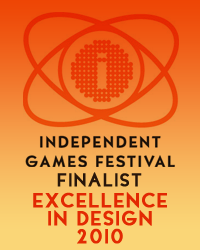You can now follow the game on Facebook.
IGF 2010 Finalist
January 4th, 2010Miegakure Selected Press
April 17th, 2009
Some comments on Miegakure after my Experimental Gameplay Workshop talk at GDC’09.
Chris Dahlen seemed to really get it,
AVC at GDC ’09, Day Four: Wake Me When Your Game Does Six Dimensions
If you remember just one quote from this afternoon’s Experimental Gameplay Session, let it be this one: “Let’s push this block into the fourth dimension.”
and,
Designer Marc ten Bosch has created a game that takes Super Paper Mario one step farther: instead of just switching from the 2D to 3D to get yourself around an obstacle, you have to think about four spatial dimensions, and switch through those to reach your goals.
And it works. I don’t really get how. I can’t think in four spatial dimensions. But Bosch has a prototype that floips into 4D, and he says he could probably code it to five or six dimensions too, if he wanted. Oh, and there’s a shadow mechanic too: if a 3D object projects a 2D shadow, a 4D object would project a 3D shadow, so … okay, I’m lost. But just wait ’til the demo! Wow.
Ryan Kuo made a good point on challenge in games.
Keita Takahashi Drew My Picture
In general, videogame challenges have either been physical (reflexes in platformers and shooters) or tactical (inventory management and battle in RPGs; things that Tom Chick plays) in nature. In these new games, challenge is conceptual as well: Can your mind piece together the world of Where Is My Heart? Can it work out the intricate dimensional folds of Miegakure?
Kim Pallister said:
Miegakure: An EGW entry by Marc Ten Bosh, this was a prototype of a game taking place in four dimensions, and it broke the brain of about half the audience members. Tricky to explain without a video, but here’s my attempt: The Kuju PSP game Crush (video) is a game taking place in a 3D world, but where players can play the world as a 2D game along a choice of axis (e.g. XY, XZ, or YZ). Miegakure takes the concept a step further by taking place in a FOUR dimensional world, but allowing the player to at any time play along three of these axis (e.g. XYZ, XYW, XZW, YZW). Rotating between spaces would cause the 3D world to sort of fold in upon itself before displaying the other view, and at that point my brain snapped. As Marc pointed out, the math for programming this kind of thing is kind of trivial, but I’d imagine getting your level designers to grok it would be trickier. I should note that both Jon Blow and Chris Hecker appeared absolutely giddy when Marc was demoing his game. Schoolgirl giddy.
To clarify, what you see is actually a slice of the world (as opposed to a projection), and there is only two sets of axis you work with.
This A.P. story is going around the world:
Experimental games get play at conference
Warren Spector mentionned the game on his blog.
One of the speaker/demo-ers showed off his ”4D game” – Miegakure – a game set in a four-dimensional space, unfolded so mere 3D mortals can (nearly) parse it. I barely understood what the guy was talking about and by the end of his brief talk and demo my head felt like it was going to explode, but, man, do I want to try to figure it out! Proof positive that there are whole universes (maybe literally) of new ideas to explore in gaming!






